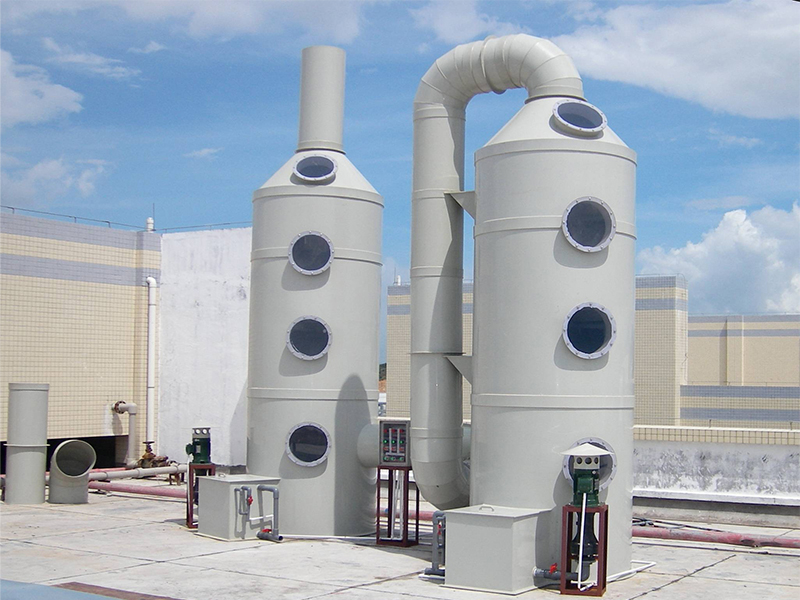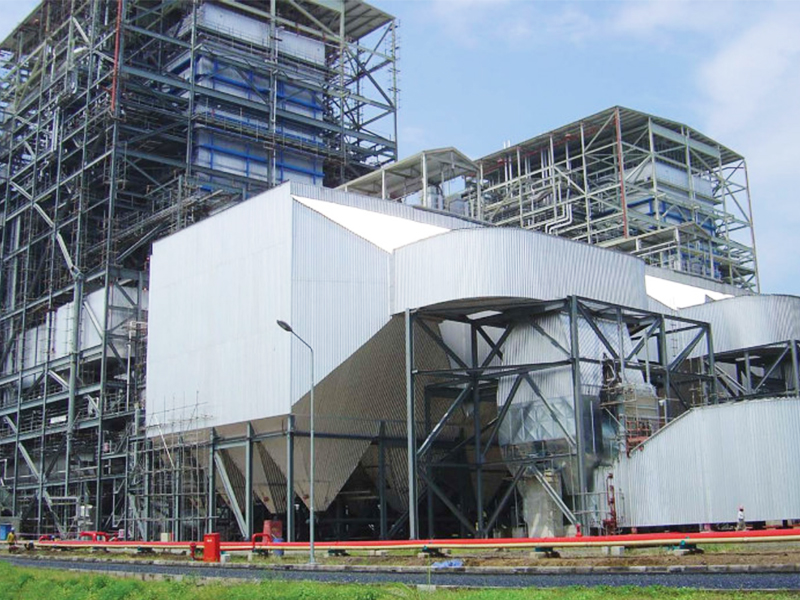0102030405
industry spray tower stainless steel scrubber exhaust gas scrubber dust remover machine gas purification
What are the details of the wet dust removal scrubber?
XJY Spray tower exists as a treatment equipment for environmental waste gas treatment. According to the working principle, it is divided into circulating water spray tower, alkali spray tower, acid spray tower (also known as pickling tower). According to the tower body material, it is divided into FRP spray tower, PP spray tower, stainless steel spray tower. Choose reasonable spray material and spray process according to the different properties of waste gas.

The counterflow of XJY Spray tower means that the inlet gas stream usually enters from the bottom of the tower and moves upward, while the liquid is sprayed downward from one or more levels. This technology can be used as a wet scrubber for air pollution control. The counterflow exposes the outlet gas with the lowest pollutant concentration to the freshest scrubbing liquid. Many nozzles are placed at different heights in the tower to spray all the gas as it moves upward through the tower. The reason for using many nozzles is to maximize the number of fine droplets that hit the pollutant particles and provide a large gas absorption surface area. In theory, the smaller the droplets formed, the more efficient the collection of gaseous and particulate pollutants.
However, the droplets must be large enough to avoid being carried out of the scrubber in the outlet gas stream after scrubbing. Therefore, the nozzles used in spray towers usually produce droplets with a diameter of 500-1000 microns. Although small in size, these droplets are large compared to the 10-50 micron sized droplets produced in a venturi scrubber. The gas velocity is kept low, from 0.3 to 1.2 m/s (1-4 ft/s), to prevent excess droplets from being carried out of the tower. To keep the gas velocity low, the spray tower must be larger than other scrubbers that handle similar gas flow rates. Another problem that occurs in spray towers is that the droplets tend to aggregate or hit the tower walls after falling a short distance. Therefore, the total liquid contact surface area is reduced, which reduces the collection efficiency of the scrubber.
In addition to the counterflow configuration, the flow in the spray tower can also be a co-current or cross-flow configuration.

picture 1 Cross flow spray tower
In XJY co-current spray tower, the inlet gas and liquid flow in the same direction. Since the gas flow does not "push" the liquid spray, the gas velocity through the vessel is higher than in a counter-flow spray tower. Therefore, co-current spray towers are smaller than counter-flow spray towers when handling the same amount of exhaust gas flow. In XJY cross-flow spray tower (also called a horizontal spray scrubber), the gas and liquid flow in directions perpendicular to each other.
In this vessel, the gas flows horizontally through multiple spray sections. The amount and quality of liquid sprayed out of each spray section can vary, and the cleanest liquid is usually sprayed out in the last set of sprays (if recycled liquid is used).
What are the characteristics of the stainless steel spray tower?
1. The equipment occupies a small area and is easy to install;
2. The water and power consumption indicators are low;
3. Corrosion-resistant, non-wear, and long service life;
4. The equipment is reliable in operation and simple and convenient to maintain.
What are the structural components of industry spray tower?
The packing layer in the XJY Spray tower is used as a mass transfer device for the contact components between the gas and liquid phases. A packing support plate is installed at the bottom of the packing tower, and the packing is placed on the support plate in a random pile. A packing pressure plate is installed above the packing to prevent it from being blown by the rising air flow. The XJY Spray tower spray liquid is sprayed from the top of the tower through the liquid distributor onto the packing and flows down along the surface of the packing. The gas is fed into the tower from the bottom, and after being distributed by the gas distribution device, it continuously passes through the gaps of the packing layer in counter current with the liquid. On the surface of the packing, the gas and liquid are in close contact for mass transfer. When the liquid flows downward along the packing layer, wall flow sometimes occurs. The wall flow effect causes the gas and liquid phases to be unevenly distributed in the packing layer, thereby reducing the mass transfer efficiency. Therefore, the packing layer in the spray tower is divided into two sections, and a redistribution device is set in the middle, and after redistribution, it is sprayed onto the lower packing.
XJY Spray towers come in a variety of sizes - small spray towers are used to handle gas flows of 0.05 m3/s (106 ft3/min) or less, and large spray towers are used to handle large exhaust flows of 50 m3/s (106,000 m3/min) or more. Units that handle large gas flows tend to be larger in size due to the lower gas velocities required.The operating characteristics of the spray tower are shown in the following table.
| Pollutants | Pressure drop (Ap) | Liquid to gas ratio (L/G) | Liquid inlet pressure (PL) | Removal efficiency | application |
| gas | 1.3-7.6 cm Water | 0.07-2.70 liters/cubic meter 0.5-20 gallons/1,000 square feet | 70-2800 kPa | 50-90 % (Efficiency is high only when the gas solubility is good) | Mining Chemical processing Industry Boilers and Incinerators Steel industry |
| particle | 0.5-3.0 inches of water | 5 gallons/1,000 cubic feet is the normal value; using pressure spray takes >10 | 70-2800 kPa | Diameter 2-8 microns |
Working Principle Information
The core functioning of the XJY Spray tower relies on the principle of wet scrubbing. As contaminated air enters the tower, it comes into contact with a fine mist of water or a chemical solution sprayed from nozzles strategically positioned within the tower. This contact facilitates the removal of pollutants through a combination of physical and chemical processes, such as absorption, adsorption, dissolution, or neutralization.
Absorption: Pollutants dissolve or are absorbed by the liquid droplets, thereby transferring from the gas phase to the liquid phase.
Reaction: Depending on the chemical composition of the scrubbing solution, pollutants may undergo chemical reactions, such as neutralization, oxidation, or reduction.
Inertial Impaction: Larger particles are intercepted by the liquid droplets due to their inertia, resulting in their removal from the gas stream.
Diffusion: Smaller particles diffuse into the liquid film surrounding the droplets, enhancing removal efficiency.

picture 2 flow chart
Types of industry spray tower
XJY Spray towers can be classified based on several criteria, including the type of scrubbing liquid used, the mechanism of contact between gas and liquid, and the specific industrial requirements. Some common types include:
XJY Packed Bed Scrubbers: These employ a packed bed of media (e.g., ceramic raschig rings, pall rings) through which the gas and liquid flow countercurrently. The packing enhances contact between the phases, improving scrubbing efficiency.

picture 3 Packed bed spray tower
XJY Venturi Scrubbers: Characterized by a convergent-divergent nozzle that accelerates the gas flow, creating a vacuum effect that draws the scrubbing liquid into the gas stream. The high-velocity mixing ensures efficient contact and pollutant removal.

picture 4 Venturi scrubber
XJY Counterflow Scrubbers: Here, the gas and scrubbing liquid flow in opposite directions, maximizing contact time and promoting efficient absorption and reaction.
XJY Crossflow Scrubbers: Designed with gas flowing horizontally across a vertically falling liquid curtain. While simpler in construction, they may require higher liquid flow rates to achieve similar removal efficiencies.
XJY Cyclone plate tower: Cyclone plate tower is a jet-type plate scrubber, the key component of which is the cyclone plate.

picture 5 Cyclone plate tower
XJY Desulfurization tower: The desulfurization tower is a tower-type equipment for desulfurization of industrial waste gas. It is easy to maintain and can achieve the effects of dust removal and desulfurization (denitrification) at the same time by configuring different dust removal agents.

picture 6 Desulfurization tower
Benefits of industry spray tower
High Efficiency: Spray towers can achieve high removal efficiencies for a wide range of pollutants, including particulate matter, acid gases, and volatile organic compounds (VOCs).
Flexibility: By adjusting the scrubbing solution or process parameters, spray towers can be tailored to address specific pollution control needs.
Energy Efficiency: Compared to some other air pollution control technologies, spray towers can operate with relatively low energy consumption.
Low Maintenance: Well-designed and properly maintained spray towers require minimal downtime for maintenance, ensuring continuous operation.
Environmentally Friendly: By reducing harmful emissions, spray towers contribute to environmental sustainability and compliance with regulatory standards.
What are the application scenarios of exhaust gas scrubber?
XJY Spray towers find widespread application across various industries, including:
Chemical Manufacturing: For controlling emissions from chemical processes, such as acid production or paint manufacturing.
Power Generation: Coal-fired power plants utilize spray towers to remove sulfur dioxide (SO2) and other pollutants from flue gases.
Metallurgical Industries: Steel, aluminum, and other metal processing facilities employ scrubbers to control emissions from furnaces and other processes.
Waste Incineration: Municipal and hazardous waste incinerators use spray towers to purify exhaust gases before release.
Food Processing: In facilities that produce odorous gases or emit particulate matter, spray towers help maintain a clean and hygienic work environment.
Conclusion
XJY Spray towers are indispensable tools in the fight against air pollution, offering a versatile and efficient solution for a wide array of industrial applications. By leveraging their advanced scrubbing capabilities, these systems contribute significantly to environmental protection and public health, while also enabling industries to operate within strict regulatory frameworks. As technology continues to evolve, spray towers will likely play an even more critical role in ensuring a cleaner, healthier future.




















